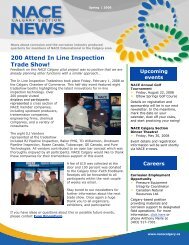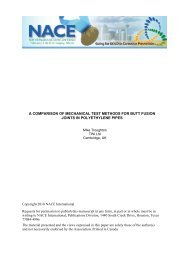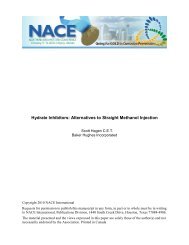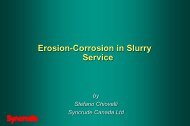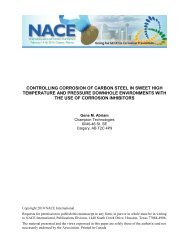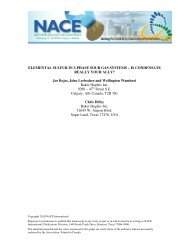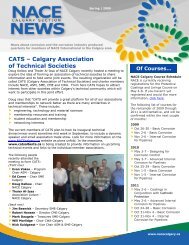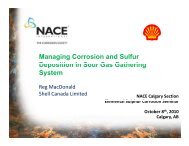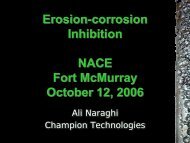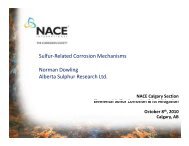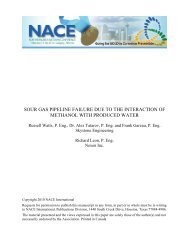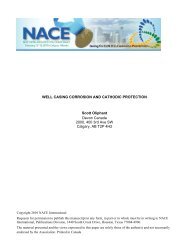Atmospheric Corrosion of Carbon Steel in the ... - NACE Calgary
Atmospheric Corrosion of Carbon Steel in the ... - NACE Calgary
Atmospheric Corrosion of Carbon Steel in the ... - NACE Calgary
You also want an ePaper? Increase the reach of your titles
YUMPU automatically turns print PDFs into web optimized ePapers that Google loves.
ATMOSPHERIC CORROSION OF CARBON STEEL<br />
IN THE PRAIRIE REGIONS<br />
William J.D. Shaw, P.Eng.<br />
Department <strong>of</strong> Mechanical Eng<strong>in</strong>eer<strong>in</strong>g<br />
University <strong>of</strong> <strong>Calgary</strong><br />
<strong>Calgary</strong>, AB<br />
Jan I. Andersson, P.Eng.<br />
Husky Oil Operations Limited<br />
<strong>Calgary</strong>, AB<br />
Copyright 2010 <strong>NACE</strong> International<br />
Requests for permission to publish this manuscript <strong>in</strong> any form, <strong>in</strong> part or <strong>in</strong> whole must be <strong>in</strong> writ<strong>in</strong>g to<br />
<strong>NACE</strong> International, Publications Division, 1440 South Creek Drive, Houston, Texas 77084-4906.<br />
The material presented and <strong>the</strong> views expressed <strong>in</strong> this paper are solely those <strong>of</strong> <strong>the</strong> author(s) and not<br />
necessarily endorsed by <strong>the</strong> Association. Pr<strong>in</strong>ted <strong>in</strong> Canada
<strong>Atmospheric</strong> <strong>Corrosion</strong> <strong>of</strong> <strong>Carbon</strong> <strong>Steel</strong> <strong>in</strong> <strong>the</strong> Prairie Regions<br />
William J.D. Shaw, P.Eng.<br />
Department <strong>of</strong> Mechanical Eng<strong>in</strong>eer<strong>in</strong>g<br />
University <strong>of</strong> <strong>Calgary</strong><br />
<strong>Calgary</strong>, AB<br />
Jan I. Andersson, P.Eng.<br />
Husky Oil Operations Limited<br />
<strong>Calgary</strong>, AB<br />
ABSTRACT<br />
An extensive study and analysis <strong>of</strong> atmospheric corrosion has been conducted which covers<br />
<strong>the</strong> <strong>the</strong>ory, understand<strong>in</strong>g and behavior <strong>of</strong> carbon steel located <strong>in</strong> <strong>the</strong> prairie regions <strong>of</strong><br />
Canada. The paper covers both general behavior and various standards for establish<strong>in</strong>g and<br />
predict<strong>in</strong>g corrosion <strong>in</strong> atmospheric conditions. Expected atmospheric corrosion <strong>of</strong> steel tanks<br />
at <strong>the</strong> Hardisty term<strong>in</strong>al as well as comparison to monitor<strong>in</strong>g <strong>in</strong>formation at this site is also<br />
presented and compared.<br />
Keywords: <strong>Atmospheric</strong> <strong>Corrosion</strong>, Time <strong>of</strong> wetness, Mechanisms, mild steel, protective films,<br />
prairie regions, corrosion prediction.
INTRODUCTION<br />
The background for <strong>the</strong> <strong>in</strong>formation <strong>in</strong> this paper is taken from three reports generated<br />
by one <strong>of</strong> <strong>the</strong> Authors [1-3]. The reports focused upon answer<strong>in</strong>g <strong>the</strong> question as whe<strong>the</strong>r <strong>the</strong><br />
ERCB Directive G-55, which requires tanks to be ei<strong>the</strong>r pa<strong>in</strong>ted or made from wea<strong>the</strong>r<br />
resistant material, has a sound corrosion eng<strong>in</strong>eer<strong>in</strong>g basis. Husky’s experience and that <strong>of</strong><br />
o<strong>the</strong>r operators, is that carbon steel that experiences natural exposure is a wea<strong>the</strong>r resistant<br />
material <strong>in</strong> <strong>the</strong> prairie region <strong>of</strong> Alberta.<br />
It is generally recognized that on <strong>the</strong> prairies <strong>the</strong> atmosphere conta<strong>in</strong>s a mild degree <strong>of</strong><br />
pollutants and a relatively dry climate with cold temperatures throughout substantial portions <strong>of</strong><br />
<strong>the</strong> year occur. This mild corrosive condition suggests that <strong>the</strong> oxide film <strong>of</strong> magnetite that<br />
normally forms adjacent to steel, once matured, is very stable, tenacious and adheres well to<br />
<strong>the</strong> steel, giv<strong>in</strong>g a protective coat<strong>in</strong>g. It will not wash <strong>of</strong>f nor is it easily removed. The question<br />
<strong>the</strong>n arises as to whe<strong>the</strong>r this oxide coat<strong>in</strong>g give sufficient protection that mild steel itself can<br />
be deemed to be corrosion resistant.<br />
Long term atmospheric corrosion monitor<strong>in</strong>g has been performed at a number <strong>of</strong><br />
locations throughout Canada and more notably for a prairie condition at Saskatoon [4]. This<br />
<strong>in</strong>formation gives direct verification to <strong>the</strong> analysis conta<strong>in</strong>ed <strong>in</strong> this paper.<br />
<strong>Atmospheric</strong> corrosion, <strong>the</strong> mechanism and parameters that control this form <strong>of</strong> metal<br />
degradation need to be clearly understood prior to undertak<strong>in</strong>g any analysis and subsequent<br />
prediction <strong>of</strong> corrosion occurr<strong>in</strong>g on carbon or mild steel <strong>in</strong> <strong>the</strong> prairie regions.<br />
Theory<br />
ATMOSPHERIC CORROSION THEORY AND MECHANISMS<br />
There is a major difference between gaseous corrosion and atmospheric corrosion,<br />
<strong>the</strong>se two corrosion conditions are both s<strong>in</strong>gly unique. Gaseous corrosion occurs at<br />
considerably elevated or high temperatures and takes place <strong>in</strong> dry gaseous environments. As<br />
opposed to this atmospheric corrosion requires an aqueous film to be present on <strong>the</strong> metal<br />
surface, and as such it is a special form <strong>of</strong> general aqueous corrosion.<br />
The pr<strong>in</strong>ciples and parameters <strong>in</strong>volved <strong>in</strong> <strong>the</strong> mechanisms and control <strong>of</strong> aqueous<br />
corrosion apply equally to atmospheric corrosion. <strong>Atmospheric</strong> corrosion is a special case <strong>of</strong><br />
aqueous corrosion, where regular electrochemical reactions and mechanisms actively control<br />
<strong>the</strong> corrosion. For atmospheric corrosion to occur sufficient moisture must be present <strong>in</strong> <strong>the</strong><br />
atmosphere. <strong>Atmospheric</strong> corrosion requires that a moisture film must form and be present<br />
with<strong>in</strong> <strong>the</strong> rust layer right down to <strong>the</strong> metal surface. This moisture film can be extremely th<strong>in</strong><br />
or it can be reasonably thick even to <strong>the</strong> level that it can be seen by eye as water resid<strong>in</strong>g on<br />
<strong>the</strong> metal and corrosion film surface. The amount <strong>of</strong> moisture required for atmospheric<br />
corrosion to beg<strong>in</strong> is known as <strong>the</strong> critical level <strong>of</strong> relative humidity. Once this level is achieved<br />
an active aqueous electrolyte has formed on <strong>the</strong> steel surface.
For atmospheric corrosion to occur, four key factors are necessary, <strong>the</strong> same as for<br />
regular aqueous corrosion to occur. These four factors are; <strong>the</strong>re must be an anode, a<br />
cathode, an ionic conduct<strong>in</strong>g electrolyte and an electrical conduct<strong>in</strong>g path between <strong>the</strong> anode<br />
and <strong>the</strong> cathode. If any one <strong>of</strong> <strong>the</strong>se four factors is miss<strong>in</strong>g corrosion does not occur. When<br />
<strong>the</strong> electrolyte is miss<strong>in</strong>g corrosion does not occur. This is <strong>the</strong> case that occurs for<br />
atmospheric corrosion at specific times. When <strong>the</strong> metal surface is dry or does not have a<br />
sufficient layer <strong>of</strong> moisture, <strong>the</strong> electrolyte is absent. At <strong>the</strong>se specific times atmospheric<br />
corrosion does not occur.<br />
The differences between regular aqueous corrosion and atmospheric corrosion are with<br />
respect to <strong>the</strong> electrolyte. Aqueous corrosion is for immersed components, where <strong>the</strong>y are<br />
cont<strong>in</strong>ually exposed to ei<strong>the</strong>r large amounts <strong>of</strong> electrolyte or <strong>in</strong> <strong>the</strong> very least relatively thick<br />
layers <strong>of</strong> ionic salt mixtures and where <strong>the</strong> presence <strong>of</strong> <strong>the</strong> electrolyte is cont<strong>in</strong>uous. In<br />
atmospheric corrosion <strong>the</strong> metal surface is at times dry and at o<strong>the</strong>r times exposed to a film <strong>of</strong><br />
aqueous electrolyte. The film <strong>of</strong> an aqueous electrolyte <strong>in</strong> atmospheric corrosion varies from a<br />
very th<strong>in</strong> surface film to a very thick film depend<strong>in</strong>g on <strong>the</strong> atmospheric conditions. This<br />
difference means that atmospheric corrosion is periodic, it is occurr<strong>in</strong>g at some specific times<br />
and not at o<strong>the</strong>rs. The magnitude <strong>of</strong> <strong>the</strong> atmospheric corrosion varies with film conditions.<br />
S<strong>in</strong>ce <strong>the</strong>se surface aqueous film conditions are constantly chang<strong>in</strong>g, it becomes more<br />
challeng<strong>in</strong>g to accurately predict <strong>the</strong> amount <strong>of</strong> corrosion. The electrolyte for atmospheric<br />
corrosion conta<strong>in</strong>s pollutants as found <strong>in</strong> <strong>the</strong> air, and <strong>the</strong>se are very site specific. Oxygen from<br />
<strong>the</strong> air is absorbed <strong>in</strong>to <strong>the</strong> th<strong>in</strong> film and diffuses to <strong>the</strong> metal surface. <strong>Atmospheric</strong> corrosion<br />
is <strong>in</strong>deed aqueous corrosion, where <strong>the</strong> electrolyte is complex <strong>in</strong> chemical species, result<strong>in</strong>g<br />
from <strong>the</strong> pollutants present. Initially with <strong>the</strong> easy presence <strong>of</strong> oxygen, <strong>the</strong> corrosion is <strong>the</strong><br />
same as aerated aqueous corrosion. Later as <strong>the</strong> oxide film grows, it becomes more difficult<br />
for oxygen to diffuse through <strong>the</strong> corrosion layer and make its way to <strong>the</strong> metal <strong>in</strong>terface. The<br />
corrosion condition <strong>the</strong>n changes and moves towards <strong>the</strong> deaerated condition.<br />
For steels, atmospheric corrosion normally results <strong>in</strong> uniform attack, thus <strong>the</strong> life <strong>of</strong> a<br />
steel component can be established based upon <strong>the</strong> rate <strong>of</strong> oxide film growth over time. This<br />
life varies considerably, accord<strong>in</strong>g to <strong>the</strong> pollutants and specific atmospheric conditions<br />
present at <strong>the</strong> site specific location. The variability and complexity <strong>of</strong> <strong>the</strong> atmospheric<br />
pollutants are what drives most <strong>of</strong> today’s ref<strong>in</strong>ement and research tak<strong>in</strong>g place <strong>in</strong> this specific<br />
area <strong>of</strong> corrosion.<br />
<strong>Corrosion</strong> mechanism<br />
Aqueous corrosion <strong>in</strong> a near neutral pH condition results <strong>in</strong> <strong>the</strong> formation <strong>of</strong> protective<br />
oxide films on <strong>the</strong> surface <strong>of</strong> mild steel. If <strong>the</strong> pH becomes fairly acidic, less than 4, <strong>the</strong> iron<br />
oxide film will dissolve and fresh metal will become exposed to <strong>the</strong> aqueous solution and very<br />
aggressive corrosion will <strong>the</strong>n occur. Alkal<strong>in</strong>e pH above 10 significantly reduces <strong>the</strong> corrosion<br />
rate. The desirable range <strong>of</strong> pH for aqueous water solutions is from 4.5 to 14, <strong>in</strong> terms <strong>of</strong>
hav<strong>in</strong>g protective film formation take place on mild steel. The pH <strong>of</strong> ra<strong>in</strong> water <strong>in</strong> <strong>the</strong> prairies<br />
[5] is between 5.5 and 6.5, provid<strong>in</strong>g a desirable pH environment for protective film formation.<br />
The corrosion <strong>of</strong> iron <strong>in</strong> an aqueous solution as occurs from prairie ra<strong>in</strong> water, starts with <strong>the</strong><br />
formation <strong>of</strong> ferro hydroxide or goethite, FeOOH. As this oxide grows or matures, it cont<strong>in</strong>ually<br />
moves upward ma<strong>in</strong>ta<strong>in</strong><strong>in</strong>g contact with <strong>the</strong> aqueous solution. Adjacent to <strong>the</strong> metal <strong>in</strong>terface<br />
<strong>the</strong> oxide changes over time to that <strong>of</strong> a th<strong>in</strong> layer <strong>of</strong> maghemite, Fe 2 O 3 . As <strong>the</strong> film grows<br />
fur<strong>the</strong>r <strong>the</strong> layer <strong>of</strong> Fe 2 O 3 moves upward and <strong>the</strong> <strong>in</strong>terface oxide layer transforms <strong>in</strong>to<br />
magnetite, Fe 3 O 4 . This film is <strong>the</strong> most protective and tenacious, giv<strong>in</strong>g excellent protection to<br />
<strong>the</strong> iron substrate. This mature film comprised <strong>of</strong> <strong>the</strong> three oxides, takes time to form, but once<br />
formed <strong>the</strong> diffusion <strong>of</strong> oxygen and water down to <strong>the</strong> metal <strong>in</strong>terface becomes more restricted<br />
and more difficult. This restriction <strong>in</strong> <strong>the</strong> oxygen diffusion is <strong>the</strong> critical step <strong>in</strong> reduc<strong>in</strong>g <strong>the</strong><br />
corrosion rate <strong>of</strong> <strong>the</strong> steel and is known as <strong>the</strong> rate determ<strong>in</strong><strong>in</strong>g step <strong>in</strong> <strong>the</strong> corrosion reaction.<br />
A schematic <strong>of</strong> <strong>the</strong> established film formation for atmospheric corrosion <strong>of</strong> steel is shown <strong>in</strong><br />
Figure 1.<br />
Controll<strong>in</strong>g parameters for atmospheric corrosion<br />
The conditions compris<strong>in</strong>g <strong>the</strong> make up <strong>of</strong> <strong>the</strong> atmosphere are very complex and<br />
cont<strong>in</strong>ually chang<strong>in</strong>g. The atmosphere can conta<strong>in</strong> acid ra<strong>in</strong>, chloride salts, nitrogen<br />
compounds, ammonia, sulfur dioxide, hydrogen sulfide, carbon dioxide and o<strong>the</strong>r <strong>in</strong>dustrial<br />
contam<strong>in</strong>ants. Climatic factors affect<strong>in</strong>g atmospheric corrosion are items such as;<br />
solar radiation<br />
relative humidity<br />
air chemistry<br />
particles carried by <strong>the</strong> atmosphere (sand, soil, dust)<br />
air temperature<br />
ra<strong>in</strong><br />
w<strong>in</strong>ds<br />
As can be appreciated <strong>the</strong>se factors are numerous, complex and <strong>in</strong>teractive. It is<br />
extremely difficult to account for all <strong>of</strong> <strong>the</strong> above factors. Fortunately it is know that a few<br />
specific factors dom<strong>in</strong>ate <strong>the</strong> atmospheric corrosion condition. This allows some simplification<br />
and <strong>in</strong> fact becomes very site specific. This is <strong>the</strong> major reason why atmospheric corrosion<br />
sites are grouped accord<strong>in</strong>g to <strong>the</strong> type <strong>of</strong> exposure or specific atmospheric conditions. The<br />
site <strong>of</strong> <strong>in</strong>terest <strong>in</strong> Alberta is normally taken to be <strong>the</strong> “rural prairie” environment, which is<br />
reasonably dry and has m<strong>in</strong>imal chloride and sulfur dioxide.<br />
A major factor <strong>in</strong> atmospheric corrosion is ra<strong>in</strong> water and its associated pH or acidity. In<br />
<strong>in</strong>dustrial sett<strong>in</strong>gs highly acidic ra<strong>in</strong> can occur. Sulfur dioxide <strong>in</strong> <strong>the</strong> presence <strong>of</strong> oxygen <strong>in</strong> ra<strong>in</strong><br />
water or <strong>in</strong> an aqueous film is easily converted to sulfuric acid, which is a major source <strong>of</strong><br />
acidity and or acid ra<strong>in</strong>. However <strong>the</strong> atmospheric condition on <strong>the</strong> prairies is only very mildly<br />
acidic.
Now days it can generally be expected that <strong>the</strong> acidity <strong>in</strong> ra<strong>in</strong>fall has decreased<br />
especially over <strong>the</strong> more recent years. This is a result <strong>of</strong> <strong>the</strong> current more str<strong>in</strong>gent<br />
environmental regulations. This means that an even a more favorable pH is occurr<strong>in</strong>g <strong>in</strong><br />
ra<strong>in</strong>fall at this time period, most likely be<strong>in</strong>g from 6 to 7. Currently <strong>the</strong> pH value is far removed<br />
from <strong>the</strong> passive oxide film breakdown, which occurs at a pH equal to 4.<br />
Temperature has a major effect on corrosion and <strong>in</strong>teracts synergistically with relative<br />
humidity. It is generally known as a temperature-humidity complex. A general rule is that<br />
corrosion can <strong>in</strong>crease by an order <strong>of</strong> magnitude for every 10 o C <strong>in</strong>crease <strong>in</strong> temperature. At<br />
freez<strong>in</strong>g, corrosion effectively stops and just above freez<strong>in</strong>g, atmospheric corrosion is<br />
<strong>in</strong>significant. <strong>Atmospheric</strong> corrosion generally peaks at an ambient temperature around 38 o C<br />
as shown <strong>in</strong> Figure 2. Therefore it can be appreciated that significant corrosion occurs at 30<br />
o C [6], while a considerably reduced amount <strong>of</strong> corrosion takes place at 20 o C and a fur<strong>the</strong>r<br />
major reduction occurs at 10 o C. <strong>Corrosion</strong> ceases altoge<strong>the</strong>r when <strong>the</strong> temperature drops to<br />
0 o C. This temperature relationship is why atmospheric corrosion at <strong>the</strong> Norman Wells station<br />
is <strong>the</strong> lowest <strong>of</strong> all <strong>the</strong> Canadian stations, as shown <strong>in</strong> Figure 3. The comb<strong>in</strong>ation <strong>of</strong> cold<br />
temperatures comb<strong>in</strong>ed with below freez<strong>in</strong>g conditions for most <strong>of</strong> <strong>the</strong> year at this station<br />
results <strong>in</strong> very m<strong>in</strong>imal atmospheric corrosion. Thus <strong>the</strong> total amount <strong>of</strong> corrosion is always an<br />
<strong>in</strong>tegration <strong>of</strong> both temperature and relative humidity act<strong>in</strong>g toge<strong>the</strong>r. If a structure such as a<br />
tank is operat<strong>in</strong>g at a high temperature, above <strong>the</strong> ambient, <strong>the</strong>re will be a reduction <strong>in</strong> <strong>the</strong><br />
normal amount <strong>of</strong> atmospheric corrosion. The high temperature <strong>of</strong> <strong>the</strong> structure <strong>in</strong> this<br />
condition will act to drive <strong>of</strong>f moisture and hence lower <strong>the</strong> relative humidity on its surface and<br />
with<strong>in</strong> its oxide. This action will work to reduce <strong>the</strong> amount <strong>of</strong> moisture that can be absorbed<br />
onto its surface and <strong>in</strong>to <strong>the</strong> corrosion oxide film layer. It will keep <strong>the</strong> surface dry for longer<br />
periods <strong>of</strong> time as compared to a regular ambient temperature surface, hence <strong>the</strong> reduction <strong>in</strong><br />
normal or expected corrosion amounts.<br />
A beneficial action <strong>of</strong> ra<strong>in</strong> that is not normally identified is that it will wash pollutant ions<br />
<strong>of</strong>f <strong>the</strong> steel surface. This wash<strong>in</strong>g action will reduce <strong>the</strong> level <strong>of</strong> corrosion. In addition a thick<br />
aqueous layer above <strong>the</strong> oxide barrier is not as corrosive as a th<strong>in</strong> aqueous layer primarily due<br />
to <strong>the</strong> dilution <strong>of</strong> ions. This means <strong>the</strong>re is a complexity to <strong>the</strong> amount <strong>of</strong> wetness occurr<strong>in</strong>g on<br />
<strong>the</strong> structures surface. This is shown <strong>in</strong> Table 1, <strong>in</strong> a very relative manner, where is can be<br />
seen that at lower humidity, more aggressive corrosion occurs as compared to a liberally wet<br />
surface [7]<br />
The magnetite oxide film that forms adjacent to <strong>the</strong> steel, once matured is very stable, it<br />
is tenacious and adheres well to <strong>the</strong> steel, it will not wash <strong>of</strong>f nor is it easily removed. Once<br />
formed and matured, it provides a long term solution to corrosion control.<br />
It should be noted from Figure 3 that coastal regions do not reach a limit<strong>in</strong>g film<br />
thickness, but ra<strong>the</strong>r cont<strong>in</strong>ue to grow. This is a result <strong>of</strong> <strong>the</strong> high chloride ion concentration <strong>in</strong><br />
<strong>the</strong>se locations which prevents magnetite oxide film formation and keeps <strong>the</strong> corrosion film<br />
grow<strong>in</strong>g at a nearly constant and cont<strong>in</strong>uous growth rate. In <strong>the</strong>se locations Wea<strong>the</strong>r<strong>in</strong>g <strong>Steel</strong>s<br />
must be used or protective coat<strong>in</strong>gs must be applied to carbon steels.
Time <strong>of</strong> Wetness<br />
For any specific location <strong>the</strong> ma<strong>in</strong> or dom<strong>in</strong>ate factor affect<strong>in</strong>g <strong>the</strong> level <strong>of</strong> atmospheric<br />
corrosion is <strong>the</strong> time <strong>of</strong> wetness, TOW. This is <strong>the</strong> time duration at which an aqueous film has<br />
formed and cont<strong>in</strong>ually wets <strong>the</strong> steel structures surface. When <strong>the</strong> surface is covered by a<br />
th<strong>in</strong> layer <strong>of</strong> aqueous electrolyte, <strong>the</strong> corrosion cell becomes active. Therefore <strong>the</strong> corrosion is<br />
active and occurr<strong>in</strong>g throughout <strong>the</strong> duration <strong>of</strong> <strong>the</strong> time <strong>the</strong> surface <strong>in</strong>terface is wet, hence <strong>the</strong><br />
parameter TOW. The TOW is caused by ra<strong>in</strong>, fog, snow, dew condensation and by capillary<br />
action as occurr<strong>in</strong>g <strong>in</strong> sufficiently elevated levels <strong>of</strong> relative humidity.<br />
Surface oxide products have a major effect on aqueous film formation. Metal oxide<br />
itself is hydroscopic and for steel a moist film is found to occur at a relative humidity level <strong>of</strong><br />
80%. This is known as <strong>the</strong> critical relative humidity level. Correspond<strong>in</strong>gly <strong>the</strong> temperature<br />
must be above 0 o C. When chloride salts are present <strong>in</strong> <strong>the</strong> atmosphere and are deposited on<br />
<strong>the</strong> steel structures surface, <strong>the</strong>y act to lower <strong>the</strong> critical relative humidity level. The chlorides<br />
are more hydroscopic than <strong>the</strong> iron oxide layer and can reduce <strong>the</strong> critical RH to a level as low<br />
as 40%. The presence <strong>of</strong> o<strong>the</strong>r salts such as ammonium sulfate, cause o<strong>the</strong>r alterations <strong>in</strong> <strong>the</strong><br />
hydroscopic effects, ei<strong>the</strong>r <strong>in</strong>creas<strong>in</strong>g or decreas<strong>in</strong>g <strong>the</strong> critical relative humidity condition. The<br />
<strong>in</strong>itial critical relative humidity curve was established by Vernon <strong>in</strong> <strong>the</strong> early 1930’s [8]. The<br />
most popular approach is to use annual <strong>in</strong>formation for values <strong>of</strong> humidity from 80% and<br />
higher, <strong>in</strong>tegrat<strong>in</strong>g <strong>the</strong> time for <strong>the</strong>se occurrences, be<strong>in</strong>g taken as <strong>the</strong> TOW. This approach is<br />
simple, fast and reasonably accurate.<br />
Major contam<strong>in</strong>ates<br />
The two most common pollutants normally considered are chlorides and sulfur dioxide.<br />
O<strong>the</strong>r pollutants affect<strong>in</strong>g atmospheric corrosion are gaseous constituents <strong>of</strong> ammonia,<br />
hydrogen sulfide, nitrous oxides and carbon dioxide. Normally <strong>in</strong> rural locations one would<br />
expect <strong>the</strong> gaseous constituents to be absent or if present to be extremely low hav<strong>in</strong>g m<strong>in</strong>imal<br />
effect. In <strong>the</strong> prairie regions both <strong>the</strong> chlorides and sulfides would also normally be expected<br />
to be absent or present <strong>in</strong> trace amounts.<br />
Pollutants <strong>of</strong> chlorides and sulphur dioxide along with TOW are measured at<br />
atmospheric corrosion stations and corrosion monitor<strong>in</strong>g sites accord<strong>in</strong>g to ei<strong>the</strong>r ASTM or ISO<br />
standards. These two pollutants are <strong>the</strong> ones most dom<strong>in</strong>ant <strong>in</strong> <strong>the</strong>ir effect on <strong>the</strong> corrosion <strong>of</strong><br />
steel. The average overall pollutant <strong>of</strong> sulfur dioxide <strong>in</strong> <strong>the</strong> prairie regions is generally be<strong>in</strong>g<br />
approximately 0.001 ppm [9], while that <strong>of</strong> chlorides is also low be<strong>in</strong>g approximately 0.15 ppm<br />
[10].<br />
STANDARDS & PREDICTIONS<br />
Standards
There are two standards organizations that specify <strong>the</strong> methods and techniques required for<br />
measurement <strong>of</strong> pollutants. These are ASTM and ISO organizations and <strong>the</strong>ir respective<br />
standards. In addition <strong>the</strong> standards cover <strong>the</strong> sett<strong>in</strong>g up and operation <strong>of</strong> site specific coupon<br />
stations. The critical level <strong>of</strong> relative humidity was established as a value <strong>of</strong> 80% RH <strong>in</strong> ISO<br />
9223 [11]<br />
In <strong>the</strong> prediction area, <strong>the</strong>re are three ma<strong>in</strong> data bases used throughout <strong>the</strong> world. The<br />
first and ma<strong>in</strong> one is ISOCORRAG [12,13] which is ma<strong>in</strong>ly comb<strong>in</strong>ed North American and<br />
European, <strong>the</strong> methodology is based <strong>in</strong> ISO 9223 [11]. The second is MICAT [14], which is<br />
ma<strong>in</strong>ly Lat<strong>in</strong> American, Spanish and Portuguese <strong>in</strong>formation, and is for mild steel result<strong>in</strong>g <strong>in</strong><br />
an Iberoamerican corrosion map. The third is ICP/UNECE [15], <strong>the</strong> United Nations Economic<br />
Commission for Europe and <strong>the</strong> International Co-operative Program on Effects on Materials.<br />
The most popular data base is <strong>the</strong> ISOCORRAG, which is <strong>the</strong> ma<strong>in</strong> one used throughout North<br />
America as well as throughout most <strong>of</strong> <strong>the</strong> world.<br />
Predictions<br />
There are many algorithms that have been developed, and cont<strong>in</strong>ue to be developed,<br />
that describe <strong>the</strong> corrosion accord<strong>in</strong>g to TOW, Cl - , and SO 2 [16-20]. These will undoubtedly<br />
cont<strong>in</strong>ue to become better and more accurate over time.<br />
Commercial computer programs can also be obta<strong>in</strong>ed to predict atmospheric corrosion,<br />
<strong>the</strong>se have built <strong>in</strong> algorithms and are based on <strong>the</strong> use <strong>of</strong> data bases for validation. A major<br />
program <strong>of</strong> this type is that <strong>of</strong> KORRFIELD [21], and can be obta<strong>in</strong>ed from <strong>the</strong> Swedish<br />
<strong>Corrosion</strong> Institute.<br />
The ISO 9223 uses classification conditions for TOW - (τ - rat<strong>in</strong>g), SO 2 - (P - rat<strong>in</strong>g) ,<br />
and Cl – (S - rat<strong>in</strong>g). The comb<strong>in</strong>ations <strong>of</strong> <strong>the</strong>se classifications result <strong>in</strong> a category - (C). The<br />
group<strong>in</strong>gs use rough numerical limits, and <strong>the</strong> categories range from mild, C 1 , to severe, C 5 .<br />
The short term or first year corrosion amounts for steel accord<strong>in</strong>g to <strong>the</strong>se categories are<br />
shown <strong>in</strong> Table 2.<br />
A popular long term algorithm based upon ISO 9223 and <strong>the</strong> ISOCORRAG approach<br />
was developed by Knotkova et al [12]. It is a general description <strong>of</strong> <strong>the</strong> <strong>in</strong>teractive parameters<br />
and does not limit itself to specific categories. The equation was established by statistically<br />
fitt<strong>in</strong>g to many data bases, it is given for steel <strong>in</strong> equation (R1) below;<br />
r = 1.3269 + 0.4313 {SO 2 } + 0.0057 {TOW} + 0.1384{Cl - }<br />
- - - - (R1)<br />
where r is corrosion rate <strong>in</strong> µm/yr, SO 2 is <strong>in</strong> µg/m 3 , TOW is <strong>in</strong> hrs/year, and Cl - is <strong>in</strong> mg/m 2 -<br />
day.<br />
The relationship can be put <strong>in</strong> more convenient corrosion units, be<strong>in</strong>g mils for a one<br />
year period, and <strong>the</strong>n becomes <strong>the</strong> relationship given <strong>in</strong> equation (R2),
= 0.0522 + 0.0170 {SO 2 } + 2.244x10 -4 {TOW} + 0.0054 {Cl - }<br />
- - - - (R2)<br />
This relationship does not give <strong>the</strong> full picture as <strong>the</strong> rate is calculated as a yearly rate<br />
and is only reasonably accurate for <strong>the</strong> first year when a protective corrosion film is <strong>in</strong>itiat<strong>in</strong>g<br />
and form<strong>in</strong>g. The rates for subsequent years will be progressively less s<strong>in</strong>ce <strong>the</strong> corrosion film<br />
will cont<strong>in</strong>ually slow down <strong>the</strong> reaction as it thickens and establishes itself <strong>in</strong>to a more stable<br />
form. For <strong>the</strong> prairies, with<strong>in</strong> a period <strong>of</strong> approximately 10 years, <strong>the</strong> film will have become<br />
very stable and will essentially stop any fur<strong>the</strong>r atmospheric corrosion from occurr<strong>in</strong>g. If a<br />
protective film does not form and <strong>the</strong> corrosion rate cont<strong>in</strong>ues, year after year, <strong>the</strong> relationship<br />
will predict an accurate corrosion condition.<br />
A fur<strong>the</strong>r predictive approach is required for long term corrosion as established from <strong>the</strong><br />
stable film formation. In <strong>the</strong> prairies <strong>in</strong>formation collected from atmospheric corrosion<br />
coupons, over a 10 year period, from <strong>the</strong> Saskatoon station is <strong>the</strong> most representative for this<br />
region. The corrosion rate follows a slow<strong>in</strong>g and limit<strong>in</strong>g exponential function as shown <strong>in</strong><br />
Figure 4.<br />
The graph <strong>in</strong> Figure 4 can be normalized and <strong>the</strong>n used for establish<strong>in</strong>g film thickness<br />
over time for <strong>the</strong> prairie regions. The normalized relationship gives <strong>the</strong> relative or fractional<br />
amount <strong>of</strong> atmospheric corrosion as a function <strong>of</strong> time. The relationship is given <strong>in</strong> equation<br />
(R3).<br />
f = 1 – e -0.486 x<br />
- - - - (R3)<br />
where f is <strong>the</strong> fractional amount <strong>of</strong> film formed and x is <strong>the</strong> number <strong>of</strong> years <strong>of</strong> exposure.<br />
The film is essentially fully established after 10 years <strong>of</strong> exposure and does not change<br />
from that time forward <strong>in</strong>to <strong>the</strong> future. This means that <strong>the</strong> progressive but dim<strong>in</strong>ish<strong>in</strong>g film<br />
growth each year is <strong>the</strong> key parameter identify<strong>in</strong>g <strong>the</strong> f<strong>in</strong>al corrosion outcome. The growth per<br />
year, <strong>in</strong> mpy, is not as mean<strong>in</strong>gful, s<strong>in</strong>ce it cont<strong>in</strong>ues to dim<strong>in</strong>ish each year until practically,<br />
from an eng<strong>in</strong>eer<strong>in</strong>g perspective, it becomes zero at <strong>the</strong> ten year <strong>in</strong>terval.<br />
The two relationships can be used toge<strong>the</strong>r, establish<strong>in</strong>g <strong>the</strong> amount <strong>of</strong> corrosion <strong>in</strong><br />
<strong>the</strong> first year us<strong>in</strong>g equation (R2) and <strong>the</strong>n extrapolat<strong>in</strong>g us<strong>in</strong>g equation (R3) for <strong>the</strong> amount <strong>of</strong><br />
mature film at 10 years. However when comb<strong>in</strong>ed <strong>the</strong> relationship under predicts <strong>the</strong> amount<br />
<strong>of</strong> corrosion by about 30 % when tested aga<strong>in</strong>st <strong>the</strong> <strong>in</strong>formation obta<strong>in</strong>ed from <strong>the</strong> Saskatoon<br />
station. For <strong>the</strong> prairies, <strong>the</strong> amount <strong>of</strong> corrosion contribution from sulphur dioxide is 9.5% and<br />
<strong>the</strong> amount <strong>of</strong> contribution from <strong>the</strong> chloride ion is ½%. The amount <strong>of</strong> contribution to <strong>the</strong><br />
corrosion from <strong>the</strong> TOW is 80% and <strong>the</strong> base constant gives 10%. This shows that TOW<br />
controls and dom<strong>in</strong>ates <strong>the</strong> corrosion. An adjustment <strong>in</strong> tun<strong>in</strong>g equation (R2) such that when<br />
equall<strong>in</strong>g <strong>the</strong> growth <strong>of</strong> <strong>the</strong> Saskatoon station for <strong>the</strong> 10 year period, results <strong>in</strong> an adjusted and<br />
comb<strong>in</strong>ed equation (R4) is given by,<br />
r = 0.1956 + 0.0637 {SO 2 } + 8.4128x10 -4 {TOW} + 0.0203 {Cl - }<br />
- - - - (R4)
The relationship, equation (R4), accurately predicts <strong>the</strong> stable film thickness or<br />
corrosion amount on flat mild steel surfaces after a 10 year exposure for any region throughout<br />
<strong>the</strong> prairies.<br />
This equation can be fur<strong>the</strong>r simplified by us<strong>in</strong>g <strong>the</strong> average values for sulfur dioxide<br />
and chloride ion as occurr<strong>in</strong>g on <strong>the</strong> prairies, s<strong>in</strong>ce <strong>the</strong>se values are fairly constant and do not<br />
vary significantly from location to location. The relationship <strong>the</strong>n becomes one <strong>of</strong> us<strong>in</strong>g only<br />
<strong>the</strong> TOW, which is location specific. The equation (R5) <strong>the</strong>n predicts <strong>the</strong> corrosion amount <strong>in</strong><br />
mils for <strong>the</strong> stable film condition achieved after a period <strong>of</strong> 10 years <strong>of</strong> exposure.<br />
r = [ 0.3863 + 8.4128x10 -4 {TOW} ] - - - - (R5)<br />
where r is <strong>in</strong> mils after a period <strong>of</strong> 10 years and TOW is <strong>in</strong> hrs/yr<br />
The relationship <strong>of</strong> stable film formation or corrosion amount <strong>in</strong> mils after a 10 year<br />
period as dependent upon TOW is shown <strong>in</strong> Figure 5. For a few select locations <strong>the</strong> 10 year<br />
corrosion amount and <strong>the</strong> correspond<strong>in</strong>g TOW is shown <strong>in</strong> Table 2.<br />
These prairie locations all predict low amounts <strong>of</strong> corrosion due to <strong>the</strong> mild and relatively<br />
dry prairie conditions as well as <strong>the</strong> long periods <strong>of</strong> time where <strong>the</strong> ambient temperature is<br />
below freez<strong>in</strong>g.<br />
HARDISTY CORROSION RESULTS<br />
Hardisty location<br />
Wea<strong>the</strong>r <strong>in</strong>formation for <strong>the</strong> Hardisty location is not available, <strong>the</strong>refore o<strong>the</strong>r<br />
surround<strong>in</strong>g major cities for which good historical wea<strong>the</strong>r <strong>in</strong>formation exists need to be used<br />
for approximat<strong>in</strong>g <strong>the</strong> TOW for <strong>the</strong> Hardisty location. The town <strong>of</strong> Hardisty lies approximately<br />
38 km southwest <strong>of</strong> Wa<strong>in</strong>wright, which places it <strong>in</strong> a regular rural sett<strong>in</strong>g. It is approximately<br />
330 km west <strong>of</strong> Saskatoon, approximately 110 km southwest <strong>of</strong> Lloydm<strong>in</strong>ster, approximately<br />
180 km sou<strong>the</strong>ast <strong>of</strong> Edmonton and approximately 260 km nor<strong>the</strong>ast <strong>of</strong> <strong>Calgary</strong>. Historic<br />
temperature and comb<strong>in</strong>ed moisture <strong>in</strong>formation from <strong>the</strong> surround<strong>in</strong>g sites <strong>of</strong> Saskatoon,<br />
Lloydm<strong>in</strong>ster, Edmonton and <strong>Calgary</strong> are used to approximate <strong>the</strong> specific TOW value for <strong>the</strong><br />
Hardisty site shown <strong>in</strong> Table 5. An averag<strong>in</strong>g <strong>of</strong> <strong>the</strong>se sites gives a TOW for Hardisty <strong>of</strong> 1522<br />
hrs/yr. The TOW values from <strong>the</strong> surround<strong>in</strong>g sites are 10 year average values.<br />
Just outside <strong>of</strong> Hardisty is a tank farm and Husky <strong>in</strong>itially had two unpa<strong>in</strong>ted storage<br />
tanks. The work <strong>in</strong> this paper was undertaken <strong>in</strong> order to establish <strong>the</strong> expected corrosion<br />
amounts that <strong>the</strong>se tanks would experience and to determ<strong>in</strong>e whe<strong>the</strong>r it would be <strong>in</strong> good<br />
practice to leave <strong>the</strong> tanks unpa<strong>in</strong>ted.<br />
Expected corrosion amounts
The expected amount <strong>of</strong> corrosion can be established us<strong>in</strong>g equation (R5), s<strong>in</strong>ce <strong>the</strong><br />
location is <strong>in</strong> a typical rural prairie region. Us<strong>in</strong>g <strong>the</strong> estimated TOW and <strong>the</strong> predictive<br />
relationship established previously, <strong>the</strong> stable and maximum corrosion thickness is expected to<br />
grow to a value <strong>of</strong> 1.67 mils. Once established after 10 years this corrosion amount is<br />
expected to rema<strong>in</strong> constant for 20 to 40 years or longer. The growth prediction over <strong>the</strong> years<br />
up to and <strong>in</strong>clud<strong>in</strong>g 10 years is given <strong>in</strong> Table 4.<br />
The corrosion value established after 10 years is extremely small, and should be compared<br />
with <strong>the</strong> corrosion allowance normally designed <strong>in</strong>to <strong>the</strong> thickness <strong>of</strong> such tanks. The<br />
corrosion allowance would normally be 100 mils, and even if apply<strong>in</strong>g a safety factor <strong>of</strong> 2, this<br />
would still give an allowance <strong>of</strong> 50 mils which is many times greater that what <strong>the</strong> tank is<br />
expected to lose from corrosion over its entire lifetime.<br />
Measured corrosion amounts<br />
A program was carried out at <strong>the</strong> Hardisty tank site us<strong>in</strong>g both coupons and direct<br />
measurements taken on <strong>the</strong> tank walls. Us<strong>in</strong>g a total <strong>of</strong> 12 coupon specimens located <strong>in</strong><br />
different locations on <strong>the</strong> tank, top, NW side, East side an average value <strong>of</strong> 0.57 mpy and a<br />
standard deviation <strong>of</strong> 0.22 mpy. These values were obta<strong>in</strong>ed us<strong>in</strong>g a 14 month exposure time.<br />
This average value can be compared to that <strong>of</strong> one year <strong>in</strong> Table 4 and also Figure 6, where it<br />
can be seen to be relatively equal to that predicted or occurr<strong>in</strong>g for Saskatoon. If anyth<strong>in</strong>g <strong>the</strong><br />
predictive relationship is giv<strong>in</strong>g a slightly more aggressive corrosion condition than that<br />
measured from <strong>the</strong> site coupons.<br />
Ultrasonic thickness read<strong>in</strong>gs were taken <strong>in</strong> a few specific locations on <strong>the</strong> tank and<br />
followed over a five year time period. Evaluation <strong>of</strong> <strong>the</strong> oxide film on <strong>the</strong> tanks <strong>in</strong>dicates <strong>the</strong><br />
film is very th<strong>in</strong> and tenacious and no measurable thickness loss has been found to occur<br />
accord<strong>in</strong>g to <strong>the</strong> ultrasonic measurements.<br />
ATMOSPHERIC CORROSION IN ALBERTA<br />
Expected atmospheric corrosion rates at various locations <strong>in</strong> Alberta<br />
Long term TOW data is available for a number <strong>of</strong> locations <strong>in</strong> Alberta <strong>in</strong>dicted <strong>in</strong> Table 5.<br />
The locations are a good representation <strong>of</strong> <strong>in</strong>dustrial and rural locations as well as prairie and<br />
mounta<strong>in</strong> locations. In all locations <strong>the</strong> TOW is lower than <strong>in</strong> Saskatoon, which was taken as<br />
<strong>the</strong> reference location. Long term sulphur dioxide data occurr<strong>in</strong>g <strong>in</strong> <strong>the</strong> atmosphere is<br />
available <strong>in</strong> a number <strong>of</strong> Alberta locations, <strong>the</strong> values are extremely low and can be taken as<br />
<strong>the</strong> average value <strong>in</strong>dicated previously.<br />
Chloride levels are low <strong>in</strong> all locations, and have negligible impact on atmospheric<br />
corrosion <strong>of</strong> carbon steel.
S<strong>in</strong>ce only small variations occur <strong>in</strong> all parameters, TOW, chloride and sulfur dioxide, as<br />
affect<strong>in</strong>g atmospheric corrosion growth and f<strong>in</strong>al film thickness, it is reasonable to expect that<br />
<strong>the</strong> corrosion rate estimated for Hardisty is representative for all locations throughout Alberta.
Comparison <strong>of</strong> carbon steel with wea<strong>the</strong>r resistant steels.<br />
Copper-Nickel/Chrome bear<strong>in</strong>g steels, with improved atmospheric corrosion resistance,<br />
such as USS Cor-Ten and Bethlehem <strong>Steel</strong> Corporation Mayari R have been on <strong>the</strong> market<br />
s<strong>in</strong>ce <strong>the</strong> mid 1930’s. In <strong>the</strong> mid 1960’s Bethlehem <strong>Steel</strong> began referr<strong>in</strong>g to its Mayari R steel<br />
as wea<strong>the</strong>r<strong>in</strong>g steel, a term now commonly used for <strong>the</strong>se types <strong>of</strong> steels.<br />
P. Albrecht et.al.[22] established a Medium Corrosivity band for Wea<strong>the</strong>r<strong>in</strong>g <strong>Steel</strong>s,<br />
based on a Modified ISO 9224 Method, that takes <strong>in</strong>to account that <strong>the</strong> corrosion rate for<br />
wea<strong>the</strong>r<strong>in</strong>g steels (and carbon steels) which is not constant dur<strong>in</strong>g <strong>the</strong> first 10 years. See<br />
Figure 7. The Medium Corrosivity Band def<strong>in</strong>es <strong>the</strong> degree <strong>of</strong> thickness loss expected from<br />
well-perform<strong>in</strong>g wea<strong>the</strong>r<strong>in</strong>g steel. When NRCC Saskatoon carbon steel data and Husky<br />
Hardisty one year corrosion coupon data are plotted, <strong>the</strong>y fit very well <strong>in</strong>to <strong>the</strong> Wea<strong>the</strong>r<strong>in</strong>g<br />
<strong>Steel</strong> “Medium” range.<br />
Compar<strong>in</strong>g <strong>the</strong> NRCC Saskatoon <strong>Carbon</strong> <strong>Steel</strong> corrosion test data with <strong>the</strong> NRCC<br />
Copper-Nickel (Wea<strong>the</strong>r<strong>in</strong>g <strong>Steel</strong>) corrosion data from all Canadian test locations, shows that<br />
carbon steel <strong>in</strong> Saskatoon <strong>in</strong> <strong>the</strong> long term, <strong>in</strong> general outperforms Wea<strong>the</strong>r<strong>in</strong>g <strong>Steel</strong>. The<br />
exceptions are wea<strong>the</strong>r<strong>in</strong>g steel <strong>in</strong> Saskatoon and <strong>in</strong> Norman Wells, NWT, known<br />
<strong>in</strong>ternationally for negligible atmospheric corrosion. This means that normal carbon steel, <strong>in</strong><br />
<strong>the</strong> prairie regions, could be considered as equivalent to that <strong>of</strong> us<strong>in</strong>g wea<strong>the</strong>r<strong>in</strong>g steels for<br />
<strong>the</strong>se regions.<br />
DISCUSSION<br />
<strong>Atmospheric</strong> corrosion <strong>of</strong> steel is controlled by <strong>the</strong> time <strong>of</strong> wetness <strong>of</strong> <strong>the</strong> metal surface.<br />
Two o<strong>the</strong>r parameters affect <strong>the</strong> corrosion, <strong>the</strong>se be<strong>in</strong>g sulphur dioxide and chloride ion. The<br />
sulphur dioxide has a reasonably strong effect; however <strong>the</strong> chloride ion does not, at least <strong>in</strong><br />
<strong>the</strong> prairie regions. The prairies have a unique environment, be<strong>in</strong>g generally fairly dry with a<br />
low relative humidity over much <strong>of</strong> <strong>the</strong> summer time. A good portion <strong>of</strong> <strong>the</strong> year sees<br />
temperatures below freez<strong>in</strong>g and <strong>the</strong>se two conditions act to limit <strong>the</strong> amount <strong>of</strong> time for which<br />
active atmospheric corrosion occurs. In addition <strong>the</strong> prairies experience low levels <strong>of</strong> both<br />
sulphur dioxide and chlorides. This makes <strong>the</strong> TOW as <strong>the</strong> most important and all dom<strong>in</strong>ate<br />
parameter caus<strong>in</strong>g <strong>the</strong> corrosion <strong>of</strong> mild steel. The pH <strong>of</strong> <strong>the</strong> ra<strong>in</strong>fall <strong>in</strong> <strong>the</strong> prairies is<br />
favourable <strong>in</strong> not attack<strong>in</strong>g any corrosion films formed on steel surfaces.<br />
Without a high sulphur or chloride environment, <strong>the</strong> corrosion film that forms on steel<br />
transforms <strong>in</strong>to a very tenacious and protective layer over time. In <strong>the</strong> prairie regions it<br />
establishes itself with<strong>in</strong> a few years and becomes stable and fully established after 10 years.<br />
This means that <strong>the</strong> corrosion effectively ceases to occur after 10 years and <strong>the</strong> steel<br />
component will have a long life from 20 to 40 years or more. This is a very unique<br />
environment <strong>in</strong> Canada and because <strong>of</strong> this; steel components will survive an extremely long<br />
life when directly exposed to <strong>the</strong> atmospheric conditions.
Predictive methods have previously been developed, primarily based upon large data<br />
bases. These methods are reasonably good for predict<strong>in</strong>g <strong>the</strong> first year amount <strong>of</strong> corrosion,<br />
but do not account for any film protection that forms and comes <strong>in</strong>to play <strong>in</strong> subsequent years.<br />
This aspect <strong>of</strong> film growth and protection has been <strong>in</strong>corporated <strong>in</strong> this paper and <strong>the</strong> best<br />
previous prediction technique has been tuned to actual atmospheric corrosion coupon<br />
<strong>in</strong>formation obta<strong>in</strong>ed at a prairie station, Saskatoon, over a 10 year period. The new predictive<br />
relationship is simple and can be applied through <strong>the</strong> prairie regions. It will give accurate<br />
results provided <strong>the</strong> sulphur dioxide level does not become elevated <strong>in</strong> any location where it is<br />
be<strong>in</strong>g used. The predictive relationship requires <strong>the</strong> time <strong>of</strong> wetness for that location. These<br />
values can be obta<strong>in</strong>ed from government wea<strong>the</strong>r data bases.<br />
The prediction <strong>of</strong> <strong>the</strong> atmospheric corrosion <strong>of</strong> mild steel at <strong>the</strong> Hardisty location is quite<br />
accurate as verified by on site coupons at this location. Ano<strong>the</strong>r parameter also comes <strong>in</strong>to<br />
play that be<strong>in</strong>g <strong>the</strong> elevated temperature <strong>of</strong> <strong>the</strong> tank surfaces. This will act <strong>in</strong> a manner that<br />
reduces <strong>the</strong> TOW, by driv<strong>in</strong>g moisture <strong>of</strong>f and reduc<strong>in</strong>g <strong>the</strong> relative humidity.<br />
Correlation <strong>of</strong> atmospheric data shows that carbon steel will perform as good or better<br />
<strong>in</strong> <strong>the</strong> prairie region <strong>of</strong> Alberta as well as Alberta <strong>in</strong> general as compared with Saskatoon. It<br />
has also been shown that carbon steel is a better choice <strong>in</strong> Alberta than wea<strong>the</strong>r<strong>in</strong>g steels.<br />
CONCLUSIONS<br />
An accurate predictive method <strong>of</strong> establish<strong>in</strong>g corrosion amounts over elapsed yearly<br />
times has been developed <strong>in</strong> this paper. This prediction technique is established for <strong>the</strong> prairie<br />
regions, as <strong>in</strong> <strong>the</strong>se regions a protective film <strong>of</strong> magnetite iron oxide grows and establishes<br />
itself over time. The film becomes fully mature with<strong>in</strong> 10 years and no fur<strong>the</strong>r measurable<br />
corrosion occurs after this period. This means that <strong>in</strong> Alberta carbon steel is a corrosion<br />
resistant material when it comes to atmospheric corrosion and as such does not require a<br />
fur<strong>the</strong>r protective coat<strong>in</strong>g such as pa<strong>in</strong>t<strong>in</strong>g.<br />
In Alberta carbon steel can be expected to have equal or better atmospheric corrosion<br />
behaviour than that <strong>of</strong> well-perform<strong>in</strong>g wea<strong>the</strong>r<strong>in</strong>g steel.<br />
The predictive method presented here is tuned to <strong>the</strong> 10 year <strong>in</strong>formation from <strong>the</strong> Saskatoon<br />
station and fur<strong>the</strong>r verified aga<strong>in</strong>st coupon tests at <strong>the</strong> Hardisty tank farm. The method<br />
<strong>in</strong>corporates <strong>the</strong> time <strong>of</strong> wetness which can be readily acquired or reasonably accurately<br />
estimated for any location <strong>in</strong> or throughout Alberta.
TABLE 1.<br />
RELATIVE EFFECT OF DEGREE OF WETNESS ON CORROSION RATE [7]<br />
Environmental<br />
condition<br />
Critical Relative<br />
Humidity<br />
Amount <strong>of</strong> water, g/m 2 Supply <strong>of</strong> corrosion<br />
products, mole/Lday<br />
0.01 30<br />
100% RH 1 0.3<br />
Covered by Dew 10 0.03<br />
Wet from Ra<strong>in</strong> 100 0.003<br />
TABLE 2.<br />
SUMMARY OF ATMOSPHERIC CORROSION OF STEEL ACCORDING TO CATEGORY<br />
[11].<br />
Category Relative Corrosivity Short Term <strong>Corrosion</strong> Rate, mils-yr<br />
C 1 very low < 0.05<br />
C 2 Low 0.05 - 1.0<br />
C 3 medium 1.0 - 2.0<br />
C 4 High 2.0 - 3.25<br />
C 5 very high > 3.25<br />
TABLE 3:<br />
SELECT 10 YEAR PREDICTED CORROSION AMOUNTS OF MILD STEEL AND<br />
CORRESPONDING TOW<br />
Location r, mils TOW, hrs/yr<br />
<strong>Calgary</strong> 1.32 1108<br />
Edmonton 1.74 1613<br />
Lloydm<strong>in</strong>ster 1.68 1541<br />
Saskatoon 1.92 1826
TABLE 4.<br />
PREDICTED ATMOSPHERIC CORROSION GROWTH RELATIONSHIP TOWARDS<br />
A FULLY ESTABLISHED CORROSION FILM THICKNESS AT 10 YEARS<br />
Year<br />
<strong>Corrosion</strong> amount, mils<br />
1 0.64<br />
2 1.04<br />
5 1.52<br />
10 1.67<br />
TABLE 5<br />
TOW ENVIRONMENT CANADA WEATHER STATIONS IN SASKATOON SK, VARIOUS<br />
ALBERTA LOCATIONS AND KAMLOOPS B.C.<br />
Edmonton Lloydm<strong>in</strong>ster Saskatoon <strong>Calgary</strong><br />
Year<br />
Hours T>0 and<br />
Hours T>0 and<br />
Hours T>0 and<br />
Hours T>0 and<br />
Percent<br />
Percent<br />
Percent<br />
RH>80%<br />
RH>80%<br />
RH>80%<br />
RH>80%<br />
Percent<br />
1997 1848 21.1 1836 21.0 1873 21.4 1111 12.7<br />
1998 1756 20.0 1347 15.4 1861 21.2 1563 17.8<br />
1999 1322 15.1 1715 19.6 2128 24.3 1189 13.6<br />
2000 1607 18.3 1826 20.8 1873 21.3 964 11.0<br />
2001 1523 17.4 1177 13.4 1667 19.0 609 7.0<br />
2002 1040 11.9 761 8.7 1597 18.2 619 7.1<br />
2003 1310 15.0 1530 17.5 1410 16.1 808 9.2<br />
2004 1906 21.7 1873 21.3 1908 21.7 1337 15.2<br />
2005 1984 22.6 1904 21.7 2059 23.5 1462 16.7<br />
2006 1831 20.9 1445 16.5 1887 21.5 1418 16.2<br />
Average 1613 18.4 1541 17.6 1826 20.8 1108 12.7<br />
Ft Mc. Murray Peace River High Level Red Deer<br />
Hours T> 0 and<br />
Hours T> 0 and<br />
Hours T> 0 and<br />
Hours T> 0 and<br />
Year RH>80% Percent RH>80% Percent RH>80% Percent RH>80% Percent<br />
1997 1220 13.9 1715 19.6 1513 17.3<br />
1998 23 0.3 1498 17.1 1754 20.0<br />
1999 225 2.6 1097 12.5 285 3.3<br />
2000 1058 12.0 1157 13.2 1645 18.7<br />
2001 1039 11.9 945 10.8 742 8.5<br />
2002 816 9.3 246 2.8 920 10.5<br />
2003 925 10.6 1070 12.2 698 8.0<br />
2004 855 9.7 897 10.2 1092 12.4<br />
2005 664 7.6 1364 15.6 1681 19.2<br />
2006 1051 12.0 1578 18.0 1788 20.4<br />
2007<br />
2008 1237 14.1<br />
2009 1608 18.4<br />
Average 1423 16.2 765 9.0 1157 13.2 1212 13.8<br />
Banff Jasper Grand Prairie P<strong>in</strong>cher Creek<br />
Hours T> 0 and<br />
Hours T> 0 and<br />
Hours T> 0 and<br />
Hours T> 0 and<br />
Year RH>80% Percent RH>80% Percent RH>80% Percent RH>80% Percent<br />
1997 1755 20.0 1262 14.4 957 10.9<br />
1998 1657 18.9 1407 16.1 1087 12.4 1127 12.9<br />
1999 1509 17.2 1360 15.5 879 10.0 826 9.4<br />
2000 1049 11.9 1440 16.4 1143 13.0 537 6.1<br />
2001 959 10.9 1481 16.9 962 11.0 626 7.1<br />
2002 476 5.4 1063 12.1 783 8.9 1096 12.5<br />
2003 895 10.2 77 0.9 705 8.0 577 6.6<br />
2004 1349 15.4 1472 16.8 1407 16.0 1281 14.6<br />
2005 1647 18.8 1906 21.8 1018 11.6 1182 13.5<br />
2006 1350 15.4 1294 14.8 1057 12.1 1170 13.4<br />
Average 1210 13.8 1326 15.1 1030 11.8 938 10.7
Table 5 cont<strong>in</strong>ued<br />
KamloopS, BC<br />
Hours T> 0 and<br />
Year RH>80% Percent<br />
1997 1669 0.19<br />
1998 1723 0.20<br />
1999 1529 0.17<br />
2000 1189 0.14<br />
2001 946 0.11<br />
2002 1303 0.15<br />
2003 1070 0.12<br />
2004 1673 0.19<br />
2005 1140 0.13<br />
2006 1039 0.12<br />
Average 1328 0.15<br />
Figure 1. Schematic representation <strong>of</strong> formation <strong>of</strong> a protective atmospheric corrosion film<br />
FIGURE 2. <strong>Atmospheric</strong> corrosion effect <strong>of</strong> temperature on iron [6]
FIGURE 3. <strong>Corrosion</strong> verses time curves for low carbon steel at various Canadian corrosion<br />
sites [4]<br />
Coupon Measurements at Saskatoon Station<br />
<strong>Corrosion</strong> Value, mils .<br />
2<br />
1.8<br />
1.6<br />
1.4<br />
1.2<br />
1<br />
0.8<br />
0.6<br />
0.4<br />
0.2<br />
0<br />
0 2 4 6 8 10 12<br />
Coupon Exposure Time, yrs<br />
FIGURE 4. <strong>Atmospheric</strong> corrosion coupon measurements at Saskatoon station
Prairies 10 yr <strong>Corrosion</strong> Values for Mild <strong>Steel</strong><br />
<strong>Corrosion</strong> Amount, mils .<br />
3<br />
2.5<br />
2<br />
1.5<br />
1<br />
0.5<br />
0<br />
0 500 1000 1500 2000 2500 3000<br />
Time <strong>of</strong> Wetness, hrs/yr<br />
FIGURE 5. <strong>Corrosion</strong> <strong>of</strong> mild steel after 10 years exposure <strong>in</strong> <strong>the</strong> prairie regions as controlled<br />
by TOW<br />
Saskatoon, Mild <strong>Steel</strong>-<strong>Atmospheric</strong> <strong>Corrosion</strong><br />
<strong>Corrosion</strong> (mm)<br />
0.05<br />
0.045<br />
0.04<br />
0.035<br />
0.03<br />
0.025<br />
0.02<br />
0.015<br />
0.01<br />
0.005<br />
0<br />
0.0457<br />
0.0419<br />
0.0279<br />
0.0188<br />
0<br />
0 2 4 6 8 10 12<br />
Years <strong>of</strong> Exposure<br />
NRCC Saskatoon<br />
<strong>Corrosion</strong> Data<br />
Hardisty <strong>Corrosion</strong><br />
Coupons<br />
FIGURE 6. Hardisty atmospheric corrosion coupons compared with atmospheric corrosion<br />
coupon measurements at Saskatoon station
Saskatoon, Mild <strong>Steel</strong>-<strong>Atmospheric</strong> <strong>Corrosion</strong><br />
<strong>Corrosion</strong> (mm)<br />
0.1<br />
0.09<br />
0.08<br />
0.07<br />
0.06<br />
0.05<br />
0.04<br />
0.03<br />
0.02<br />
0.01<br />
0<br />
0<br />
0.0279<br />
0.0188<br />
0.005mm/yr<br />
0.0419<br />
0.0457<br />
0 2 4 6 8 10 12 14<br />
Years <strong>of</strong> Exposure<br />
0.001mm/yr<br />
Saskatoon <strong>Corrosion</strong> Coupons<br />
Hardisty <strong>Corrosion</strong> Coupons<br />
Wea<strong>the</strong>r<strong>in</strong>g <strong>Steel</strong> Medium<br />
Corrosivity Band<br />
FIGURE 7. Medium corrosivity band for wea<strong>the</strong>r<strong>in</strong>g steels with Hardisty atmospheric<br />
corrosion coupons compared with atmospheric corrosion coupon measurements<br />
at Saskatoon station.<br />
REFERENCES<br />
1. Dr. W.J.D. Shaw, P.Eng.,“Hardisty <strong>Atmospheric</strong> <strong>Corrosion</strong> Monitor<strong>in</strong>g Program”, Husky<br />
<strong>in</strong>-house report., 2007<br />
2. Dr. W.J.D. Shaw, P.Eng., “<strong>Atmospheric</strong> <strong>Corrosion</strong> Theory and Understand<strong>in</strong>g”, Husky<br />
<strong>in</strong>-house report., 2007<br />
3. Dr. W.J.D. Shaw, P.Eng., “Expected <strong>Atmospheric</strong> <strong>Corrosion</strong> <strong>of</strong> <strong>Steel</strong> Tanks at Hardisty<br />
Term<strong>in</strong>al”, Husky <strong>in</strong>-house report., 2007<br />
4. Gibbons, E.V. , “The <strong>Corrosion</strong> Behavior <strong>of</strong> <strong>the</strong> major Architectural and Structural<br />
Metals <strong>in</strong> Canadian Atmospheres: Summary <strong>of</strong> Ten-Year Results <strong>of</strong> Group 1“ ,<br />
NRCC_0011630, 1970 Figure25.<br />
5. CSA-370, 2004, Connectors for Masonry, Missisauga, Ontario, Figure 2.8<br />
6. Barton, K, Protection Aga<strong>in</strong>st <strong>Atmospheric</strong> <strong>Corrosion</strong>, John Wiley & Sons, 1976, pg. 55.<br />
7. Mattsson, E., „The atmospheric <strong>Corrosion</strong> Properties <strong>of</strong> Some Common Structural<br />
Materials – A Comparative Study“ , Material Performance, July 1982, pgs. 9-19<br />
8. Vernon, W.H.J., “British Non-Ferrous Metals Research Association (Second<br />
experimental report to <strong>the</strong> atmospheric corrosion research committee)”, Transactions<br />
Faraday Society, 1927, V23, N74, pgs.113-185<br />
9. CSA – A370, 2004, Connectors for Masonry, Mississauga, Ontario, Figure 2.9<br />
10. <strong>Corrosion</strong> <strong>of</strong> Materials, ASM Handbook, V13C, 2001, pg.44.
11. ISO 9223, <strong>Corrosion</strong> <strong>of</strong> Metals and alloys – corrosivity <strong>of</strong> atmospheres – Classification,<br />
1992.<br />
12 Knotkova, d., Boschek, P. and Kreislova, K., “Results <strong>of</strong> IOSCORRAG Program:<br />
Process<strong>in</strong>g <strong>of</strong> One-Year Data <strong>in</strong> Respect to Corrosivity Classification”, ASTM STP<br />
1239, 1995, pgs. 38-55..<br />
13. Dean,S.W., “Analysis <strong>of</strong> Eight Years <strong>of</strong> Exposure Data from <strong>the</strong> USA Contribution to <strong>the</strong><br />
ISOCORRAG Program”, 13 th International <strong>Corrosion</strong> Congress, <strong>NACE</strong>, 1998, paper<br />
011, pgs. 1-8.<br />
14. Morcillo, M., “<strong>Atmospheric</strong> <strong>Corrosion</strong> <strong>in</strong> Ibero-America: The MICAT project”, ASTM STP<br />
1239, 1995, pgs. 257-275.<br />
15. Tidblad, J., Mikhailov, A.A. and Kucera, V., Statistical Analysis <strong>of</strong> 8 Years Material<br />
Exposure and Acceptable Deterioration and Pollution Levels, Swedish <strong>Corrosion</strong><br />
Institute, Stockholm, Sweden, 1998, UNECE ICP Report No. 30.<br />
16. Kl<strong>in</strong>esmith, D.E., McCuen, R.H. and Albrecht, P., “Effect <strong>of</strong> environmental Conditions on<br />
<strong>Corrosion</strong> rates”, J. <strong>of</strong> Materials <strong>in</strong> Civil Eng<strong>in</strong>eer<strong>in</strong>g, 2007, V19, N2, pgs. 121-129<br />
17. Kihira, H., Senuma, T., Tanaka, M., Nishioka, K., Fujii, Y. and Sakata, Y., “A <strong>Corrosion</strong><br />
Prediction Method for Wea<strong>the</strong>r<strong>in</strong>g <strong>Steel</strong>s”, <strong>Corrosion</strong> Science, 2005, V47, pgs. 2377-<br />
2390.<br />
18. Roberge, P.R., Klassen, R.D. and Haberecht, P.W., “<strong>Atmospheric</strong> Corrosivity Model<strong>in</strong>g<br />
-a Review”, Materials & Design, 2002, V23, pgs. 321-330.<br />
19. Tidblad, J., Mikhailov, A.A. and Kucera, V., “Model for <strong>the</strong> Prediction <strong>of</strong> <strong>the</strong> Time <strong>of</strong><br />
Wetness from Average, Annual Data on Relative Air Humidity and Air Temperature”,<br />
Protection <strong>of</strong> Metals, 2000, V36, N6, pgs. 533-540.<br />
20. ASTM G 101, Standard Guide for Estimat<strong>in</strong>g <strong>the</strong> <strong>Atmospheric</strong> <strong>Corrosion</strong> Resistance <strong>of</strong><br />
Low-alloy <strong>Steel</strong>s, 2004.<br />
21. KORRFIELD Data Base and Prediction Program, Swedish <strong>Corrosion</strong> Institute ,<br />
Stockholm, Sweden, 2005. www.claes.taxen@corr-<strong>in</strong>stitute.se<br />
22. Albrecht, P. and Hall Jr. T., “<strong>Atmospheric</strong> <strong>Corrosion</strong> Resistance <strong>of</strong> Structural <strong>Steel</strong>“ .<br />
Journals <strong>of</strong> Materials <strong>in</strong> Civil Eng<strong>in</strong>eer<strong>in</strong>g, January/February. 2003, 150 th Anniversary<br />
Paper, pgs. 2-24.



